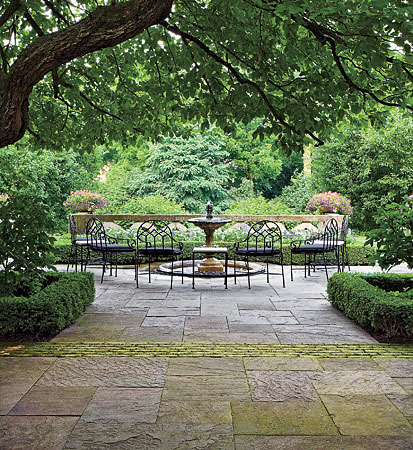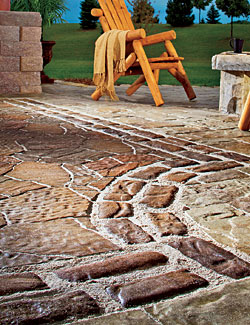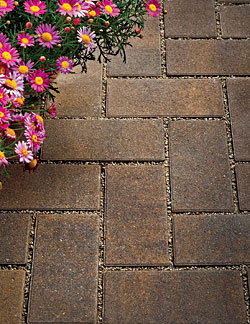
For this patio, Mariani Landscape used dimensional cut bluestone with a porous brick border, allowing moss to grow through for added interest.
Q: I’m thinking of having a stone or brick patio installed in my yard. What do I need to know?
A: Congratulations. You’ve wisely decided against a giant slab of concrete. The freeze-and-thaw cycle of Midwestern seasons can wreak havoc on concrete, opening up cracks and causing other trouble. Individually laid stone pavers, bricks, concrete paving stones, and crushed stone are better bets, weatherwise.
Manufactured concrete pavers, such as those offered by Belgard, offer the widest range of colors, sizes, textures, and styles and are generally cheaper than natural materials—about 30 percent less per square foot after installation, estimates Ken O’Neill, a senior vice president of Belgard.

Three types of manufactured pavers from Belgard’s Natural collection are artfully combined here.
Permeable pavers are an increasingly popular choice. “They allow the pavement surface to channel water into the lower subbase and base material,” O’Neill says, which controls storm water runoff and ground pollution. They can also be combined with a storage system to collect rainwater for irrigation.
Reclaimed pavers, often granite cobbles or antique bricks collected during road repair and construction projects, are attractive options that offer an Old World look, says Tony LoBello, design director at Mariani Landscape in Lake Bluff. “Old bricks typically are darker, running from a pinkish red to burgundy or rich brown,” he adds. They’re also thicker and heavier than modern bricks—and more expensive, at around $26 per square foot installed. While granite cobbles are virtually indestructible, LoBello says, century-old fired-clay bricks can be fragile, so expect a bit of breakage during installation. LoBello believes both are great for older homes and for patio borders. “Right away when you put them down, they look old,” he says.
He sometimes likes to set reclaimed bricks inside a natural stone border, creating an effect “like an Oriental carpet.” Alternating the direction and pattern of the bricks—in basketweave and herringbone designs, for example—adds visual interest, especially welcome in large areas.
LoBello also likes new fired-clay bricks from Illinois Brick Company and sand-finished Cushwa brick from Redland Brick; installation runs about $18 per square foot.

Strong and durable but with a clean, modular look, Aqua Roc permeable pavers from Belgard are a good choice for large patios, as well as for driveways, walkways, and other heavily trafficked areas.
Natural stone pavers commonly used by our experts include Indiana limestone, with its even gray color; Wisconsin flagstone (a type of limestone) which comes in a range of sandy colors and often has a pebbly or fossil-filled texture; and bluestone, a slate-colored stone from the East Coast that is versatile and goes with almost anything, LoBello says.
Michele McKay, owner of Chicago-based McKay Landscape Architects, has paired bluestone pavers with chips of crushed bluestone to create tranquil patios. “The area with pavers is great for tables and chairs, and the gravel visually highlights other areas,” she says, noting that chips, which run about $12 per square foot installed, are better for low-traffic zones.
Natural stone is the most expensive option. LoBello ballparks the installation cost per square foot between $25 (for bluestone) to $36 (for Wisconsin flagstone), but the size of the pieces and number of cuts make a big difference. Stones can have irregular natural shapes or be cut into squares, rectangles, or any desired form, McKay says. Laying irregular shapes involves slightly more planning, but it is not necessarily more expensive. In general, the bigger the pieces, the higher the price.
Designing and installing a patio isn’t a job for amateurs; enlisting a pro is money well spent. Landscape architects will audit your site’s characteristics, taking special note of how water drains in your yard. Without proper leveling and pitch, a patio can collect water or drain onto your home’s foundation. Once your site is level, a high-quality installation begins with a layer of gravel six to eight inches deep, followed by two inches of bedding sand, which acts as a leveling pad and cushioning agent. In the first year or two, as the pavers settle, the sand “squeezes up through the joints and helps interlock the stones,” O’Neill says.
One thing all our experts agree on: Spend the money to install your patio right the first time. The majority of calls LoBello receives are about tearing out unsuccessful old projects. “Masonry is probably the single most expensive component of your landscape,” he says, “but done right, it will last forever.”
Have a design or renovation question? E-mail us at chicagohome@chicagomag.com and we’ll do our best to answer. Sorry, we cannot take questions by phone or guarantee individual responses. We might already have an answer for you—check out our Expert Advice archive.
Photograph: (Mariani) Linda Oyama Bryan



